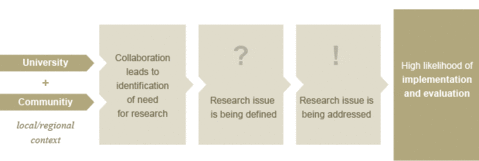Research resulting from service learning
In the course of service learning subject-oriented collaboration between the university and the community may result in the identification of needs for research. Community-based research (or community-based participatory research) provides an opportunity to conduct research in a collaborative and participatory manner with community organizations and the university jointly working on a research issue.
Community-based research originated in the U.S., where it has, to date, been widely applied in the social services and the health care sectors, but it can easily cross disciplines. It is normally triggered by a concrete need for research. Its objective is to facilitate and induce social change by combining knowledge with action. This implies that all parties involved jointly discuss the problem and also how it can be resolved. The community enables the researchers to gain access to a problem by providing them with insights into real-life settings. The researchers, in turn, share their expert knowledge and research results with the community and subsequently point out possible alternatives and actions.
Compared to conventional research methods, this offers the following advantages:
- specific needs of the community customers are taken into consideration
- the customers accept and are willing to implement the findings
- research addresses a concrete need
In service learning, the central research questions may arise directly from the tasks the students have taken on and are underpinned with academic content by their teachers. As a general rule, defined problem areas and challenges are addressed with the goal of coming up with concrete ideas to improve the situation or approach them on the basis of scientific research and processes. Community-based research can therefore, on the one hand, address issues with regard to the community partners` working or framework conditions. On the other hand, community-based research can reach out to groups of people, who are in difficult social circumstances or who are encountering problems due to their:
- age
- health
- gender
- ethnic origin
- family situation
- educational background
- economic situation
- particular experiences with discrimination (e.g. violence, mobbing, crime victims and so forth)
- political, religious and philosophical convictions and views
Community-based research can principally be applied to all disciplines. It identifies and addresses research questions as they arise. The solutions developed are then made available to the community partners in question or beneficiaries depending on their proper context.
- Identification of needs for the education and information of specific target groups in order to develop and test suitable instruments and procedures for them (such as action guidelines and training concepts)
- identification of problems in coping with everyday life situations in order to develop improved methods or aids (e.g. modified technical instruments or procedures)
- identification of existing potentials among the beneficiaries in order to develop self-help concepts.
The local community, its stakeholders as well as the social, economic and legal framework conditions have a special role when it comes to defining issues of relevance to community-based research. This means that community-based research targets the local community, its self-perception, framework conditions, structures and processes.
Topics and questions to be addressed in the course of community-based research may – for example – be:
- to what extent can for-profit marketing concepts be transferred to non-profit organizations → development of suitable marketing concepts
- how organizational strategies can be developed in line with the specific resources available to non-profit organizations
- how social awareness for current or potential problem areas can be raised → development and implementation of instruments, procedures and measures for agenda setting
- what role volunteers play for the development and personnel resources of non-profit-organizations → development of adequate personnel and organizational strategies and concepts
- to what extent physical handicaps impact access to modern means of communication → development of adjusted operating structures respectively possibilities for input/output


